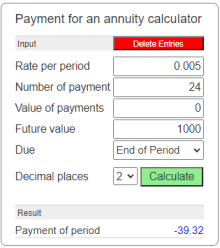Pmt returns payment for an annuity based on periodic and fixed payments
The Pmt Function returns a value specifying the payment for an annuity based on periodic, fixed payments and a fixed interest rate.
An annuity is a series of fixed cash payments made during a period of time. An annuity can be a loan (such as a home mortgage) or an investment (such as a monthly savings plan).
The Rate and NPer arguments must be calculated using payment periods expressed in the same units. For example, if Rate is calculated using months, NPer must also be calculated using months.
For all arguments, cash paid (such as deposits to savings) is represented by negative numbers; cash received (such as dividend checks) is represented by positive numbers.
|

Rate per period
The interest rate per period. For example, if you get a car loan at an annual percentage rate (APR) of 10 percent and make monthly payments, the rate per period is 0.1/12, or 0.0083.
Number of payment
The total number of payment periods in the annuity. For example, if you make monthly payments on a four-year car loan, your loan has a total of 4 × 12 (or 48) payment periods.
Value of payments
The present value (or lump sum) that a series of payments to be paid in the future is worth now. For example, when you borrow money to buy a car, the loan amount is the present value to the lender of the monthly car payments you will make.
Future value
The future value or cash balance you want after you have made the final payment. For example, the future value of a loan is $0 because that is its value after the final payment. However, if you want to save $50,000 during 18 years for your child's education, then $50,000 is the future value. If omitted, 0 is assumed.
Due
Due date specifies when payments are due. This argument must be either End of Period if payments are due at the end of the payment period, or Begin of Period if payments are due at the beginning of the period.
|
|